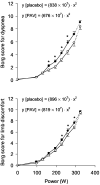Inspiratory muscles do not limit maximal incremental exercise performance in healthy subjects
- PMID: 17134946
- PMCID: PMC4313890
- DOI: 10.1016/j.resp.2006.10.008
Inspiratory muscles do not limit maximal incremental exercise performance in healthy subjects
Abstract
We investigated whether the inspiratory muscles affect maximal incremental exercise performance using a placebo-controlled, crossover design. Six cyclists each performed six incremental exercise tests. For three trials, subjects exercised with proportional assist ventilation (PAV). For the remaining three trials, subjects underwent sham respiratory muscle unloading (placebo). Inspiratory muscle pressure (P(mus)) was reduced with PAV (-35.9+/-2.3% versus placebo; P<0.05). Furthermore, V(O2) and perceptions of dyspnea and limb discomfort at submaximal exercise intensities were significantly reduced with PAV. Peak power output, however, was not different between placebo and PAV (324+/-4W versus 326+/-4W; P>0.05). Diaphragm fatigue (bilateral phrenic nerve stimulation) did not occur in placebo. In conclusion, substantially unloading the inspiratory muscles did not affect maximal incremental exercise performance. Therefore, our data do not support a role for either inspiratory muscle work or fatigue per se in the limitation of maximal incremental exercise.
Figures



References
-
- Aaron EA, Seow KC, Johnson BD, Dempsey JA. Oxygen cost of exercise hyperpnea: implications for performance. J. Appl. Physiol. 1992;72:1818–1825. - PubMed
-
- ATS Dyspnea: Mechanisms, assessment, and management: A consensus statement. Am. J. Respir. Crit. Care Med. 1999;159:321–340. - PubMed
-
- Babcock MA, Pegelow DF, Harms CA, Dempsey JA. Effects of respiratory muscle unloading on exercise-induced diaphragm fatigue. J. Appl. Physiol. 2002;93:201–206. - PubMed
-
- Babcock MA, Pegelow DF, Taha BH, Dempsey JA. High frequency diaphragmatic fatigue detected with paired stimuli in humans. Med. Sci. Sports Exerc. 1998;30:506–511. - PubMed
-
- Barclay JK. A delivery-independent blood flow effect on skeletal muscle fatigue. J. Appl. Physiol. 1986;61:1084–1090. - PubMed

